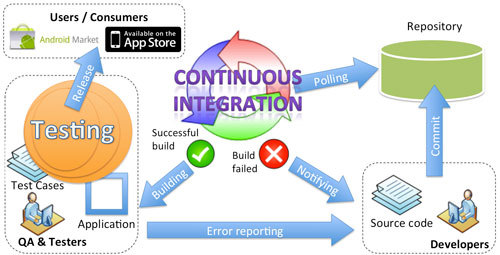
In the past, the only goal of testing a software program was finding flaws. The goal was to raise the software’s overall quality. However, recent years have seen a tremendous expansion in the scope of software testing. Automation testing has consistently led the way in the sector regarding software testing. Software testing is expected to advance significantly more than it did over the preceding ten years, according to the most recent trends in test automation. Selenium 4.0, the current version, is one of the best platforms to help testers and developers test their applications. Let’s know more about Selenium and the opportunities it will explore in the coming future.
What is Selenium?
Selenium is an open-source and free automated testing framework that is compatible with a wide range of web browsers and operating systems and is used to validate online applications. Additionally, a variety of programming languages, such as Java, Python, C#, and others that are very similar to these, can be used to create Selenium Test Scripts.
Selenium Software is a collection of software, and each is created to specifically address the Selenium QA testing needs of a specific industry.
Foundation of Automation Testing: Selenium 4.0
In October 2021, Selenium’s launched fourth major version was finally made available. Since Selenium 3 had been made available to the public five years prior, significant advancements in the underlying technology had been made. The functionality of Selenium 4 has undergone several improvements, including enhanced command formatting for accessing a Selenium Grid, more robust Docker support, the ability to recognize the parent frame, and more.
One of the new features of Selenium 4.0 is the capacity to support relative locators, enhanced window and tab management for web browsers, a native Chromedriver for the Microsoft Edge browser, and many others. Since its debut, Selenium 4.0 has received much positive feedback and acceptance as an improved version of its earlier editions.
Predictions and Goals for Selenium 4.0 in 2023

1. Codeless Automation Testing
The codeless automation testing solutions are created using AI technology, and visual modeling speeds up the creation of test cases specifically suited for automation testing. Testers can use these tools to create test scenarios without any programming experience, reducing the time spent on tiresome test cases.
Some of the benefits of codeless automated testing are listed below:
- Non-technical users can study the test cases quickly because they are generated without using any code.
- People unfamiliar with computer languages or coding can build and construct test cases.
- Developing and automating test cases is accelerated since the learning curve is shortened.
The greater use of non-coding solutions is one of the test automation trends that will take off in 2023.
2. Self-repairing test automation will grow in popularity
Artificial Intelligence (AI) and Machine Learning (ML) are frequently used to solve specific problems and boost the effectiveness of the development and testing processes. AI is used in the testing process to shorten the test life cycle in all aspects of testing, such as automation, performance, functional, regression, and so on.
AI must become a crucial part of software testing tools to effectively utilize the promise of automation testing and artificial intelligence in the testing process. A significant quantity of data is produced during each testing cycle, which can be used to identify and correct any test failures. The data and insights learned from each test iteration can be fed into the AI and ML algorithms.
The data will be used to train the algorithm, and the learning it experiences will help the testing tool determine the “anticipated behavior” for the different tests. Since the device can flag a test as “failed” if there is even the tiniest deviation from the predicted behavior, this enables judgments to be taken during the runtime.
3. Implementation of QAOps
QAOps is a recent iteration of DevOps. To create high-quality software, the software operations and quality assurance teams closely coordinate their efforts. Three pillars, i.e., continuous integration, testing, and development, form the foundation of the QAOps methodology. The testing process’s quality and efficiency are improved by including quality assurance in the pipeline that QAOps utilizes to deliver software.
QAOps helps to speed up and streamline the software development process because it adheres to the DevOps philosophy. Shorter development life cycles provide organizations with more time to focus on enhancing the product’s functionality. QAOps will offer users a superior experience because it relies on continuous testing.
To increase the effectiveness of their quality assurance (QA) process and use DevOps in software testing and quality assurance, more software product firms are expected to use QAOps in 2023.
4. Using a Distributed Cloud for Testing on Multiple Browsers
The Selenium automation testing approach cannot be scaled on a local Selenium Grid. Due to this issue, many companies have switched their automated browser testing initiatives to cloud-hosted systems. Given the rise in the number of devices, operating systems, and browser releases each year, cloud-based cross-browser testing is a more sensible option.
Because the global customer base is growing, there may be periodic delays in the execution of the tests if the cloud is located in a remote location. Distributed cloud will be used exponentially more frequently in 2023, enhancing test execution speed and efficiency.
5. Organizations are adopting the shift-left testing method with increasing frequency
Due to the growth of Agile and other methodologies, testing is still ongoing at the end of the development life cycle. On the other hand, shift-left testing, which enables testing to be done substantially earlier in the product life cycle, is adopted to a large extent. One of the many benefits of shift-left testing is the early defect detection and rapid communication between the development and testing teams. A decrease in the price of testing and development is an additional benefit.
The shift-left testing methodology promotes cooperation between the development and testing teams to achieve common goals. Identifying problems early in product development is easier using shift-left testing techniques. This is because the timelines for product development and release may be delayed if bugs are discovered during later phases of product development.
Shift-left testing will be one of the most significant developments in test automation in 2023 as more and more organizations prepare to reap profit from this testing strategy.
6. Utilizing the Cloud for Browser Testing
Making a website responsive for a certain mobile device, tablet, or desktop computer is no longer necessary. Those times have passed. At this time, the vast majority of companies and clients opt for websites created with mobile devices in mind. There are hundreds of different gadgets on the market, each with a different resolution and web browser. It might be expensive to set up such an extensive testing infrastructure. As a result, most companies and people have started switching to cross-browser testing platforms hosted in the cloud.
7. Large-Scale Application of Hyper-Automation
A combination of techniques known as hyper-automation can be used to take advantage of the benefits of AI-driven decision-making. These tools include machine learning (ML), robotic process automation (RPA), artificial intelligence (AI), and natural language processing (NLP). Hyper Automation-based tools can increase productivity by doing routine tasks without requiring human intelligence.
Organizations are expected to utilize a combination of AI and RPA for test automation and analyzing automation reports. Hyper Automation is one of the test automation concepts that will become more commonplace in 2023.
8. Mobile device automation testing

Organizations have started implementing the “mobile-first” approach to website development throughout the last few years. Organizations have begun to create native apps for their internet applications in recent years. This pattern started emerging a while ago. The company will put a bigger emphasis on testing mobile applications due to the steadily increasing number of mobile applications.
It is realistic to expect companies to look for testers with prior experience with automated mobile app testing, given that there are now more mobile devices than ever, each with its own screen resolution and operating system behavior.
In 2023, test automation frameworks like Selendroid, Appium, and Robotium will spread more widely due to recent advancements in the field. Additionally, there will be a rise in the demand for testers with knowledge of these technologies.
9. Robotic process automation implementation in blockchain applications
When we hear “blockchain technology,” we quickly conjure images of Bitcoin and other digital currencies. Still, as of late, the range of uses for this technology has considerably increased. It also benefits supply chain management and the food and shipping industries. This is because blockchain technology provides the highest security imaginable for all financial transactions.
An increase in the demand for QA specialists with specialized domain expertise in testing blockchain apps will be the best trend to watch for in the test automation field in 2023. In light of this, testing specialists should be knowledgeable about automated technologies and the domains they test.
With the aid of these tools, you may test the transaction execution and application programming interface (API) in a blockchain system. Most blockchain development is done using the agile software development methodology. But when it comes to testing, the “Shift left” tactic is gaining popularity as a way to reduce the number of flaws.
10. Smarter Test Automation
Current software testing trends are increasingly emphasizing multi-device testing as the number of linked devices keeps growing. This ensures that apps function properly on all connected devices, such as smart home devices and smartphones, laptops, tablets, and other mobile devices. All devices, regardless of their shape, size, or operating system, are successfully tested thanks to multi-device testing. This is true for all gadget types. As more individuals utilize several devices, it is anticipated that the scope of multi-device testing will keep growing in the upcoming years.
To introduce, LambdaTest is a cloud-based digital experience testing platform that enables developers and testers to perform real-time and automation testing using multiple test automation tools like Selenium, Playwright, and over 3000+ browsers, operating systems, and devices. LambdaTest supports parallel testing and testing across several devices to reduce the overall time and effort required for testing. You can visit the platform and sign in to learn more about them.
11. Exploratory testing will start to be used more frequently
As automation testing becomes increasingly important across several industries, exploratory testing will eventually become a part of every QA team member’s routine practice. Automation testers will be asked to find more unique test cases focused on their web application in the extra bandwidth available because automation testing will help to handle the repetitive tasks.
With automation testing, they can emphasize exploratory testing more because they can create crucial test scenarios that scripted testing would have missed. The increasing relevance of DevOps and Agile in the software development and testing departments and the shorter time to market will necessitate exploratory testing shortly.
Conclusion
Even though automation aims to eliminate the need for manual testing, it goes without saying that machines cannot work independently. It needs a human’s help to operate a machine. Although the enormous progress automation testing has made in recent years, manual testers are still greatly needed. An experienced manual tester can write test cases so that they require fewer automation scripts while still providing comprehensive coverage. After launching various versions, Selenium is at a place where it will undoubtedly get better with time. Automation testing tools are here to stay, and Selenium versions will keep improving in the coming time.




